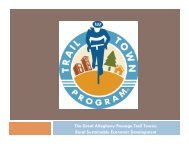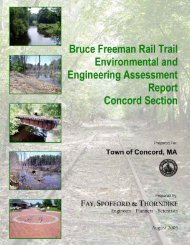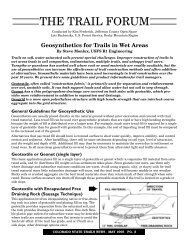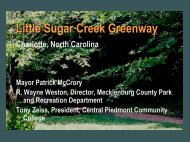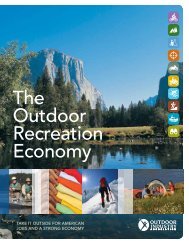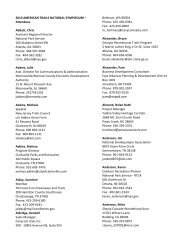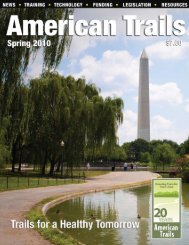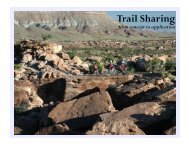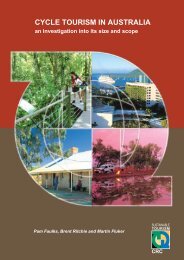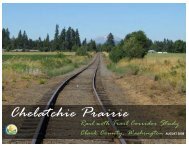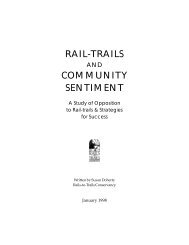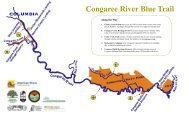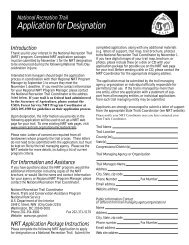The future of trails and greenways in America The future ... - Atfiles.org
The future of trails and greenways in America The future ... - Atfiles.org
The future of trails and greenways in America The future ... - Atfiles.org
- No tags were found...
You also want an ePaper? Increase the reach of your titles
YUMPU automatically turns print PDFs into web optimized ePapers that Google loves.
Surfaces for accessible <strong>trails</strong>?From USDA Forest Service Accessibility Guidebook on Outdoor Recreation <strong>and</strong> TrailsBy Janet Zeller, USFS Accessibility Program ManagerTHE SURFACE OF AN Outdoor Recreation AccessibilityRoute <strong>and</strong> the surface surround<strong>in</strong>g constructed featuresmust be firm <strong>and</strong> stable. No exceptions are allowed. Slipresistance is not required because leaves <strong>and</strong> needles, dirt,ice, snow, <strong>and</strong> other surface debris <strong>and</strong> weather conditionsare components <strong>of</strong> the natural environment that would bedifficult, if not impossible, to avoid.Pav<strong>in</strong>g the Wilderness?Does a firm <strong>and</strong> stable surface always mean concrete <strong>and</strong>asphalt? No! <strong>The</strong> surface provision states that the type <strong>of</strong>surface material used should be appropriate to the sett<strong>in</strong>g <strong>and</strong>level <strong>of</strong> development. Some natural soils can be compactedso they are firm <strong>and</strong> stable. Other soils can be treated withstabilizers without drastically chang<strong>in</strong>g their appearance.Many surfaces that appear natural <strong>and</strong> that meet the firm <strong>and</strong>stable requirements also are available on the market.Designers are encouraged to <strong>in</strong>vestigate these options <strong>and</strong>use surfac<strong>in</strong>g materials that are consistent with the site’slevel <strong>of</strong> development <strong>and</strong> that require as little ma<strong>in</strong>tenance aspossible.What is Firm <strong>and</strong> Stable?What sort <strong>of</strong> surface is firm <strong>and</strong> stable? In general, if theanswer to both <strong>of</strong> the follow<strong>in</strong>g questions is yes, the surfaceis probably firm <strong>and</strong> stable:• Could a person ride a narrow-tired bicycle across the surfaceeasily without mak<strong>in</strong>g ruts?• Could a fold<strong>in</strong>g stroller with small, narrow plastic wheelsconta<strong>in</strong><strong>in</strong>g a three-year-old be pushed easily across the surfacewithout mak<strong>in</strong>g ruts?Firm <strong>and</strong> stable surfaces prevent assistive devices from s<strong>in</strong>k<strong>in</strong>g<strong>in</strong>to the surface, which would make movement difficultfor a person us<strong>in</strong>g crutches, a cane, a wheelchair, or otherassistive device. In the accessibility guidel<strong>in</strong>es, the st<strong>and</strong>ardassistive device is the wheelchair because its dimensions,multiple mov<strong>in</strong>g surface contact po<strong>in</strong>ts, <strong>and</strong> four wheels<strong>of</strong>ten are difficult to accommodate. If a person us<strong>in</strong>g awheelchair can use an area, most other people also can usethat area.Construction Tips on Surfac<strong>in</strong>g MaterialsGenerally, the follow<strong>in</strong>g materials provide firmer surfacesthat are more stable:Crushed rock can provide a firm <strong>and</strong> stable surface• Crushed rock (rather than uncrushed gravel)• Rock with broken faces (rather than rounded rocks)• A rock mixture conta<strong>in</strong><strong>in</strong>g a full spectrum <strong>of</strong> sieve sizes(rather than a s<strong>in</strong>gle size)• Hard rock (rather than s<strong>of</strong>t rock that breaks down easily)• Rock that passes through a 1⁄2-<strong>in</strong>ch (13-millimeter) screen• Rock material that has been compacted <strong>in</strong>to 3- to 4-<strong>in</strong>ch(75- to 100-millimeter) thick layers (not thicker layers)• Material that is moist, but not too wet, before it is compacted(rather than material that is compacted when it is dry)• Material that is compacted with a vibrat<strong>in</strong>g plate compactor,roller, or by h<strong>and</strong> tamp<strong>in</strong>g (rather than material thatis laid loose <strong>and</strong> compacted by use)<strong>The</strong> Forest Service Accessibility Guidebook on OutdoorRecreation <strong>and</strong> Trails will help users <strong>in</strong>tegrate accessibility<strong>in</strong>to plann<strong>in</strong>g, design, construction, <strong>and</strong> ma<strong>in</strong>tenance <strong>of</strong> outdoorrecreation facilities <strong>and</strong> <strong>trails</strong> while ma<strong>in</strong>ta<strong>in</strong><strong>in</strong>g the naturalsett<strong>in</strong>g. It provides detailed <strong>in</strong>formation about accessibilityrequirements <strong>in</strong> an easy-to-use format, with photos,illustrations, <strong>and</strong> design tips, hotl<strong>in</strong>ks, <strong>and</strong> sidebars. Thisguidebook will also help Forest Service personnel, partners,contractors, <strong>and</strong> Federal <strong>and</strong> State agencies work<strong>in</strong>g <strong>in</strong> cooperationwith the Forest Service underst<strong>and</strong> how to apply theForest Service Outdoor Recreation Accessibility Guidel<strong>in</strong>es<strong>and</strong> Forest Service Trail Accessibility Guidel<strong>in</strong>es.See www.<strong>America</strong>nTrails.<strong>org</strong> for more <strong>in</strong>formationon Accessible Trails, <strong>in</strong>clud<strong>in</strong>g l<strong>in</strong>ks to the new ForestService Accessibility Guidebook <strong>and</strong> many otherarticles <strong>and</strong> resources.34NEW YEARS 2007 <strong>America</strong>n Trails



